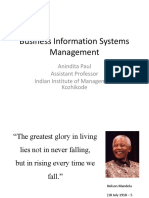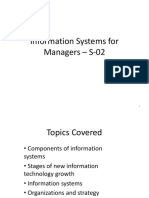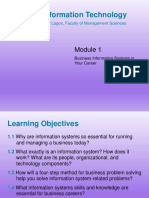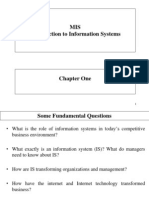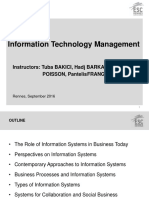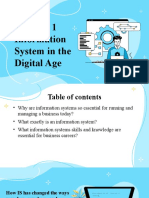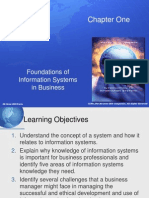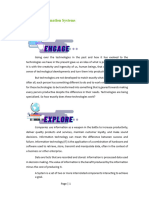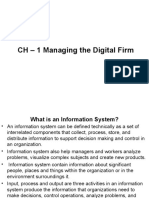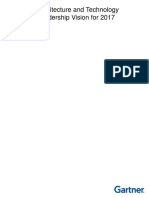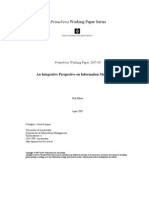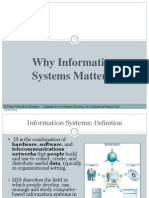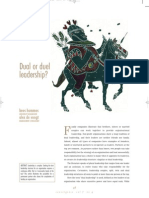Business Information Systems Management: Anindita Paul Assistant Professor Indian Institute of Management Kozhikode
Business Information Systems Management: Anindita Paul Assistant Professor Indian Institute of Management Kozhikode
Uploaded by
Amit SinghaCopyright:
Available Formats
Business Information Systems Management: Anindita Paul Assistant Professor Indian Institute of Management Kozhikode
Business Information Systems Management: Anindita Paul Assistant Professor Indian Institute of Management Kozhikode
Uploaded by
Amit SinghaOriginal Description:
Original Title
Copyright
Available Formats
Share this document
Did you find this document useful?
Is this content inappropriate?
Copyright:
Available Formats
Business Information Systems Management: Anindita Paul Assistant Professor Indian Institute of Management Kozhikode
Business Information Systems Management: Anindita Paul Assistant Professor Indian Institute of Management Kozhikode
Uploaded by
Amit SinghaCopyright:
Available Formats
Business Information Systems
Management
Anindita Paul
Assistant Professor
Indian Institute of Management
Kozhikode
The greatest glory in living
lies not in never falling,
but in rising every time we
fall.
Nelson Mandela
(18 July 1918 5
December 2013)
2
Syllabus
Overview: Business Information Systems Management
Perspectives Case-Makemytrip
Module 1: Information Systems and Managerial Challenges
Enterprise IT Applications for Operational Excellence
E-Business and E-Commerce
Knowledge Management and Decision-Making with IT
IT Infrastructure and Management
3
Syllabus (contd.)
Module 2: Impact of IT on Business Strategy
Business Models
IT impact on Business Models and Organizations
Strategic Information Systems Planning
IT Service and IT Project Delivery
Module 3: IT Leadership and Social Impact
IT Governance and Leadership
E-Governance and ICT for Development
Ethical Issues in ICT and Green IT
Society of the Internet
4
Syllabus (contd.)
Text Book
K.C. Laudon & J.P. Laudon (2013), Management
Information Systems: Managing the Digital Firm, 12
edition, Pearson Education
Lynda M Applegate, Robert D. Austin, Deborah L.
Soule (2008) Corporate Information Strategy and
Management 8th Edition. McGraw Hill International
Other readings will be provided
5
Scheme of Evaluation
Mid Term Exam 25 Marks
End Term Exam 30 Marks
Seminar 05 Marks
Quiz/Course Participation 20 Marks
Project & Presentation 20 Marks
_____________________________________
Total 100 Marks
6
Quiz
Case quiz on the day of the case
Prescribed readings for each session will be
included in the exams (including both mid and
end-term exam)
7
Seminar
Project Groups of 5-6 students each will be formed/assigned and named.
Each group will choose at least two relevant and current topics related to
the session of the day they will be presenting.
The topics have to be submitted the first week of class in their order of
preference.
One of the chosen topics will be approved by the faculty.
In case the group is not able to decide or if the topic decided is not
approved by the faculty then a topic will be assigned to the group that
they need to present on.
Seminar slides should be forwarded to the faculty at least a day in advance
of the presentation.
The presentation should be no more than 10 mins and should include
a short description of the topic,
why is it important,
relevant industry examples
8
Term Project
Objective - To learn how various concepts learned in
the course are applied across business organizations in
India.
Topics that explore a particular aspect of IT in an Indian
organization will be assigned.
Primary or secondary sources could be used for
information gathering.
Interim report to be submitted by 5 Feb and arrange a
time to meet faculty on 3 Feb and 4 Feb for briefing
progress.
Final report to be submitted by 2 Mar.
Final Presentations on 6 Mar and 11 Mar.
9
Overview: Business Information
Systems Management
BISM 1
Anindita Paul
Readings Laudon and Laudon Chapters 1 & 2
Learning Objective
Information systems in business and their relationship
to globalization
Why information systems are so essential in business
today
Information system and its components
Complementary assets and its significance
Business Processes and relation to IS
Systems and their use to different management groups
in a business
Systems for collaboration and teamwork
11
Information Systems
vs.
Information Technology
12
Problem: No sure-shot way to improve team performance. Lack of player performance
related data
Solutions: Used information systems to capture play and analyze statistical data connected to
video clips on categories such as who bowled, who is the batsman, who was the non-striker,
where did the ball pitch, what did the ball do, where was the ball hit, no. of runs, who fielded,
how did he field it, which end did he throw, what was the outcome of the ball etc.
Sports Mechanics collected and organized fine-grained statistical data and related it to
associated video clips.
Demonstrates ITs role in providing new services that can help managers in decision-making
and viewing player moves based on set criteria
Illustrates the benefits of utilizing technology for enhancing capabilities of decision-making
IPL Team Strikes Gold with IT
13
How information systems are transforming business
Increase in wireless technology use, Web sites
Increased business use of Web 2.0 technologies
Cloud computing, mobile digital platform allow more distributed work,
decision-making, and collaboration
Globalization opportunities
Internet has drastically reduced costs of operating on global scale
Presents both challenges and opportunities
The Role of Information Systems in Business Today
14
The Role of Information Systems in Business Today
Information Technology Capital Investment
Information technology capital investment, defined as hardware, software, and
communications equipment, grew from 32 percent to 52 percent of all invested capital
between 1980 and 2009.
15
In the emerging, fully digital firm
Significant business relationships are digitally enabled and mediated
Core business processes are accomplished through digital networks
Key corporate assets are managed digitally
Digital firms offer greater flexibility in organization and management
Time shifting, space shifting
The Role of Information Systems in Business Today
16
Growing interdependence between ability to use information technology
and ability to implement corporate strategies and achieve corporate
goals
Business firms invest heavily in information systems to achieve six
strategic business objectives:
Operational excellence
New products, services, and business models
Customer and supplier intimacy
Improved decision making
Competitive advantage
Survival
The Role of Information Systems in Business Today
17
The Role of Information Systems in Business Today
The Interdependence Between Organizations and Information Technology
In contemporary systems there is a growing interdependence between a firms information systems and its
business capabilities. Changes in strategy, rules, and business processes increasingly require changes in
hardware, software, databases, and telecommunications. Often, what the organization would like to do
depends on what its systems will permit it to do.
Figure 1.2
18
Information system:
Set of interrelated components
Collect, process, store, and distribute information
Support decision making, coordination, and control
Information vs. data
Data are streams of raw facts
Information is data shaped into meaningful form
Perspectives on Information Systems
19
Perspectives on Information Systems
Data and Information
Raw data from a supermarket checkout counter can be processed and organized to produce
meaningful information, such as the total unit sales of dish detergent or the total sales revenue
from dish detergent for a specific store or sales territory.
20
Perspectives on Information Systems
Functions of an
Information System
An information system contains
information about an
organization and its surrounding
environment. Three basic
activitiesinput, processing, and
outputproduce the information
organizations need. Feedback is
output returned to appropriate
people or activities in the
organization to evaluate and
refine the input. Environmental
actors, such as customers,
suppliers, competitors,
stockholders, and regulatory
agencies, interact with the
organization and its information
systems.
21
Perspectives on Information Systems
Information Systems
are More Than
Computers
Using information systems
effectively requires an
understanding of the
organization,
management, and
information technology
shaping the systems. An
information system
creates value for the firm
as an organizational and
management solution to
challenges posed by the
environment.
22
Organizational dimension of information systems
Hierarchy of authority, responsibility
Senior management
Middle management
Operational management
Knowledge workers
Data workers
Production or service workers
Perspectives on Information Systems
23
Perspectives on Information Systems
Levels in a Firm
Business organizations are
hierarchies consisting of three
principal levels: senior
management, middle
management, and operational
management. Information
systems serve each of these
levels. Scientists and
knowledge workers often work
with middle management.
24
Organizational dimension of information systems
Separation of business functions
Sales and marketing
Human resources
Finance and accounting
Manufacturing and production
Unique business processes
Unique business culture
Organizational politics
Perspectives on Information Systems
25
Management dimension of information systems
Managers set organizational strategy for responding to business
challenges
In addition, managers must act creatively:
Creation of new products and services
Occasionally recreating the organization
Perspectives on Information Systems
26
Technology dimension of information systems
Computer hardware and software
Data management technology
Networking and telecommunications technology
Networks, the Internet, intranets and extranets, World Wide Web
IT infrastructure: provides platform that system is built on
Perspectives on Information Systems
27
Business perspective on information systems:
Information system is instrument for creating value
Investments in information technology will result in superior returns:
Productivity increases
Revenue increases
Superior long-term strategic positioning
Perspectives on Information Systems
28
Business information value chain
Raw data acquired and transformed through stages that add value
to that information
Value of information system determined in part by extent to which it
leads to better decisions, greater efficiency, and higher profits
Business perspective:
Calls attention to organizational and managerial nature of
information systems
Perspectives on Information Systems
29
Perspectives on Information Systems
The Business Information Value Chain
From a business perspective, information systems are part of a series of value-adding activities for
acquiring, transforming, and distributing information that managers can use to improve decision
making, enhance organizational performance, and, ultimately, increase firm profitability.
30
Perspectives on Information Systems
Variation in Returns on
Information Technology
Investment
Although, on average,
investments in information
technology produce returns
far above those returned by
other investments, there is
considerable variation
across firms.
31
Investing in information technology does not guarantee good returns
Considerable variation in the returns firms receive from systems
investments
Factors:
Adopting the right business model
Investing in complementary assets (organizational and management
capital)
Perspectives on Information Systems
32
Complementary assets:
Assets required to derive value from a primary investment
Firms supporting technology investments with investment in
complementary assets receive superior returns
Example: invest in technology and the people to make it work properly
Perspectives on Information Systems
33
Complementary assets include:
Organizational assets, e.g.
Appropriate business model
Efficient business processes
Managerial assets, e.g.
Incentives for management innovation
Teamwork and collaborative work environments
Social assets, e.g.
The Internet and telecommunications infrastructure
Technology standards
Perspectives on Information Systems
34
Business Processes
and
Information Systems
35
Business processes:
Workflows of material, information, knowledge
Sets of activities, steps
May be tied to functional area or be cross-functional
Businesses: Can be seen as collection of business processes
Business processes may be assets or liabilities
Business Processes and
Information Systems
36
Business Processes and
Information Systems
The Order Fulfillment Process
Fulfilling a customer order involves a complex set of steps that requires the close coordination of
the sales, accounting, and manufacturing functions.
37
Systems from a constituency perspective
Transaction processing systems: supporting operational level
employees
Management information systems and decision-support
systems: supporting managers
Executive support systems: supporting executives
Types of Information Systems
38
Relationship of systems to one another
TPS: Major source of data for other systems
ESS: Recipient of data from lower-level systems
Data may be exchanged between systems
In reality, most businesses systems are only loosely
integrated (but they are getting better!)
Types of Information Systems
39
Enterprise applications
Systems for linking the enterprise
Span functional areas
Execute business processes across firm
Include all levels of management
Four major applications:
Enterprise systems
Supply chain management systems
Customer relationship management systems
Knowledge management systems
Types of Information Systems
40
Types of Information Systems
Enterprise
Application
Architecture
Enterprise
applications
automate processes
that span multiple
business functions
and organizational
levels and may
extend outside the
organization.
41
Enterprise systems
Collects data from different firm functions and stores data in single
central data repository
Resolves problem of fragmented, redundant data sets and systems
Enable:
Coordination of daily activities
Efficient response to customer orders (production, inventory)
Provide valuable information for improving management decision
making
Types of Information Systems
42
Alternative tools that increase integration and expedite the flow of
information
Intranets:
Internal company Web sites accessible only by employees
Extranets:
Company Web sites accessible externally only to vendors and
suppliers
Often used to coordinate supply chain
Types of Information Systems
43
E-business
Use of digital technology and Internet to drive major business
processes
E-commerce
Subset of e-business
Buying and selling goods and services through Internet
E-government:
Using Internet technology to deliver information and services to
citizens, employees, and businesses
Types of Information Systems
44
Technology for collaboration and teamwork
15 categories of collaborative software tools
Email and instant messaging, White boarding, Collaborative
writing, Web presenting, Collaborative reviewing, Work scheduling,
Event scheduling, Document sharing /wikis, File sharing, Mind
mapping, Screen sharing, Large audience, Webinars, Audio
conferencing, Co-browsing, Video conferencing
Contd
Systems for Collaboration and Teamwork
45
Social Networking
Wikis
Virtual Worlds
Internet-based Collaboration Environments
Virtual meeting systems (telepresence)
Google Apps/Google sites
Microsoft SharePoint
Lotus Notes
Systems for Collaboration and Teamwork
46
Information systems department:
Formal organizational unit responsible for information technology
services
Often headed by chief information officer (CIO)
Other senior positions include chief security officer (CSO), chief
knowledge officer (CKO), chief privacy officer (CPO)
Programmers
Systems analysts
Information systems managers
The Information Systems Function in Business
47
End users
Representatives of other departments for whom applications are
developed
Increasing role in system design, development
IT Governance:
Strategies and policies for using IT in the organization
Decision rights
Accountability
Organization of information systems function
Centralized, decentralized, etc.
The Information Systems Function in Business
48
Next Class-
o Groups to submit their seminar topics
o Read Makemytrip case
49
You might also like
- PMO Playbook EntireDocument181 pagesPMO Playbook EntirePre MANo ratings yet
- Forrester Report Customer Experience Strategy Best PracticesDocument17 pagesForrester Report Customer Experience Strategy Best Practices2mNo ratings yet
- Sybrid Health Premier Management Company Vs Sohail Mohammad, Sajid Fiaz DC-21-05382Document46 pagesSybrid Health Premier Management Company Vs Sohail Mohammad, Sajid Fiaz DC-21-05382110063No ratings yet
- Information Security PolicyDocument169 pagesInformation Security PolicyKishor Kumar75% (4)
- ISEM547 Project1 FinalDocument14 pagesISEM547 Project1 FinalPratik GaikwadNo ratings yet
- IT Governance CharterDocument34 pagesIT Governance CharterIzoorViinaNo ratings yet
- Unlocking The Performance of The Chief Information Officer (CIO)Document24 pagesUnlocking The Performance of The Chief Information Officer (CIO)Mirjana Pejic BachNo ratings yet
- Business Information SystemsDocument49 pagesBusiness Information SystemsPooja PunjabiNo ratings yet
- ISM-02 (Introduction To Information Systems - 2)Document33 pagesISM-02 (Introduction To Information Systems - 2)Abhishek PatilNo ratings yet
- CH 02Document32 pagesCH 02Ehtasham RazaNo ratings yet
- Information Systems Information Systems in OrganizationsDocument9 pagesInformation Systems Information Systems in OrganizationsRocky KaurNo ratings yet
- Information Systems in Business Today: CASE: UPS Global Operations With The DIAD IVDocument42 pagesInformation Systems in Business Today: CASE: UPS Global Operations With The DIAD IVShaoli MofazzalNo ratings yet
- 49049chapter 1 MISDocument36 pages49049chapter 1 MISArif KamalNo ratings yet
- Week1laudon Mis16 PPT Ch01 KL CE-916jan23Document70 pagesWeek1laudon Mis16 PPT Ch01 KL CE-916jan23Abdul HadiNo ratings yet
- Session 1 BookDocument48 pagesSession 1 BookHa VyNo ratings yet
- Chapter One: Foundations of Information Systems in BusinessDocument45 pagesChapter One: Foundations of Information Systems in BusinessChaitanya PawarNo ratings yet
- Femi Module 1 LectureDocument46 pagesFemi Module 1 Lecturefaith olaNo ratings yet
- Ch1 - IS in Global Business Today (1) - TaggedDocument50 pagesCh1 - IS in Global Business Today (1) - Taggedmuhameedabd1No ratings yet
- Mis Unit 1Document37 pagesMis Unit 1Salomé Aartieda ZambranoNo ratings yet
- Week 1 2 - Foundation of Information System in BusinessDocument58 pagesWeek 1 2 - Foundation of Information System in BusinessFahmi_mukhtarNo ratings yet
- Intro To MISDocument40 pagesIntro To MISMA. CHRISTINE BODUANNo ratings yet
- CH 02Document39 pagesCH 02YESSICA CECILIA SINAGANo ratings yet
- MIS Introduction To Information SystemsDocument33 pagesMIS Introduction To Information SystemsFarhan Israq AhmedNo ratings yet
- IS 402E Information Technology Management: Instructors: Tuba BAKICI, Hadj BARKAT, Arnaud Poisson, Pantelis FrangoudisDocument78 pagesIS 402E Information Technology Management: Instructors: Tuba BAKICI, Hadj BARKAT, Arnaud Poisson, Pantelis FrangoudisSam DariNo ratings yet
- Management Information SystemDocument39 pagesManagement Information SystemYt NoobNo ratings yet
- Information System in Global Business TodayDocument38 pagesInformation System in Global Business TodayMohammed BharmalNo ratings yet
- Lecture-02 Lecture-02: Information Systems in Global Business Information Systems in Global BusinessDocument19 pagesLecture-02 Lecture-02: Information Systems in Global Business Information Systems in Global BusinessMUSHFIQUR RAHMAN100% (1)
- Foundations of Information Systems in BusinessDocument56 pagesFoundations of Information Systems in BusinessYasir HasnainNo ratings yet
- 201 امن Management Information SystemsDocument51 pages201 امن Management Information SystemsTaiseer Al-RatroutNo ratings yet
- Chapter 01 Information System in The Digital AgeDocument32 pagesChapter 01 Information System in The Digital Agefennie lohNo ratings yet
- Chapter 4 Information System in Today BusinessDocument40 pagesChapter 4 Information System in Today BusinesstirusewhmichaelNo ratings yet
- Laudon Mis16 PPT Ch01Document54 pagesLaudon Mis16 PPT Ch01twumNo ratings yet
- Introduction To Information SystemDocument40 pagesIntroduction To Information SystemSajan kcNo ratings yet
- Instructor: BUS-516 Computer Information SystemsDocument30 pagesInstructor: BUS-516 Computer Information SystemsAnonymous Z8TDNtcUNo ratings yet
- T1 & T2 - Introduction & Business Process ManagementDocument37 pagesT1 & T2 - Introduction & Business Process ManagementrawanalbawardiNo ratings yet
- MIS17-Chapter 01Document61 pagesMIS17-Chapter 01OPI GamingNo ratings yet
- Foundations of Information Systems in BusinessDocument39 pagesFoundations of Information Systems in BusinessMahmoud AbdelazizNo ratings yet
- Global E-Business and Collaboration: Case: Walmart S Retail Link Supply Chain Dr. Mohammad Naveed AhmedDocument40 pagesGlobal E-Business and Collaboration: Case: Walmart S Retail Link Supply Chain Dr. Mohammad Naveed AhmedShaoli MofazzalNo ratings yet
- MIS Week 1Document90 pagesMIS Week 1SbhgtvhcyNo ratings yet
- IS Development Business Value of Information Systems and Management KnowledgeDocument45 pagesIS Development Business Value of Information Systems and Management Knowledgeahmadamminudin89No ratings yet
- Unit 6-10Document100 pagesUnit 6-10lucky dolphinNo ratings yet
- Management Information SystemsDocument34 pagesManagement Information Systemscyberprime_prasetyoNo ratings yet
- Ybs Slayt1Document49 pagesYbs Slayt1sudenur77ozcanNo ratings yet
- MIS Joined PDF by SarjoonDocument211 pagesMIS Joined PDF by SarjoonNishad AhamedNo ratings yet
- Management Information SystemDocument57 pagesManagement Information SystemBHUWNESH AGARWALNo ratings yet
- Management Information Systems: Jane P. Laudon Kenneth C. Laudon Prentice-Hall IncDocument29 pagesManagement Information Systems: Jane P. Laudon Kenneth C. Laudon Prentice-Hall IncAnargya WidyatamaNo ratings yet
- Information Systems in Global Business TodayDocument38 pagesInformation Systems in Global Business Todayshobhit_garg6No ratings yet
- Management Information Systems 8/e Chapter 1 Managing The Digital FirmDocument42 pagesManagement Information Systems 8/e Chapter 1 Managing The Digital Firmahmadamminudin89No ratings yet
- Lecture 1 - Is in Business TodayDocument26 pagesLecture 1 - Is in Business TodaySiddhartha PatraNo ratings yet
- Lecture 2 Need For Information SystemDocument46 pagesLecture 2 Need For Information Systemmaryallaine02No ratings yet
- Module 1 Mis PDFDocument48 pagesModule 1 Mis PDFTinku JoyNo ratings yet
- Chap01 ManagementDocument61 pagesChap01 ManagementAnonymous rWn3ZVARLgNo ratings yet
- Enterprise and Global Management of Information TechnologyDocument46 pagesEnterprise and Global Management of Information TechnologyShashi ShekharNo ratings yet
- U01 Information Systems 2022 July 7Document44 pagesU01 Information Systems 2022 July 7Noppon SETTASATIENNo ratings yet
- Chap01 - IS in OrganizationsDocument90 pagesChap01 - IS in OrganizationsRis NapolisNo ratings yet
- Strategic Information System: Usman SattarDocument42 pagesStrategic Information System: Usman SattarRaaied Jaffer100% (1)
- MIS_ch01Document36 pagesMIS_ch01hakimstars2003No ratings yet
- FIS Lecture 2Document33 pagesFIS Lecture 2nathanmutamba01No ratings yet
- Lecture - 1 - Introduction of Information SystemsDocument32 pagesLecture - 1 - Introduction of Information Systemsnitesh tekriwalNo ratings yet
- CH - 1 Managing The Digital FirmDocument22 pagesCH - 1 Managing The Digital FirmAbhijit_Patkar_2711No ratings yet
- Week 12 - Ch. 11 &12Document62 pagesWeek 12 - Ch. 11 &12kjvaexNo ratings yet
- Chapter 1: Information in Business Systems TodayDocument44 pagesChapter 1: Information in Business Systems TodaySara Mae LagrazonNo ratings yet
- MIS and Services Chapter 1-Importance of IS ManagementDocument48 pagesMIS and Services Chapter 1-Importance of IS ManagementMuluneh DebebeNo ratings yet
- Introduction To Information Systems Introduction To Information SystemsDocument39 pagesIntroduction To Information Systems Introduction To Information SystemsSaad WaqarNo ratings yet
- Management of DataDocument25 pagesManagement of DataSujal ManandharNo ratings yet
- Touchpad Information Technology Class 10: Skill Education Based on Windows & OpenOffice Code (402)From EverandTouchpad Information Technology Class 10: Skill Education Based on Windows & OpenOffice Code (402)No ratings yet
- CIO 10 Point Plan For IT ModernizationDocument18 pagesCIO 10 Point Plan For IT Modernizationjacoscribd2000No ratings yet
- Enterprise Architecture and Technology Innovation Leadership Vision For 2017Document26 pagesEnterprise Architecture and Technology Innovation Leadership Vision For 2017Fernando GuzmanNo ratings yet
- Case Study: Are We A Team?: Cast of Major CharactersDocument3 pagesCase Study: Are We A Team?: Cast of Major Charactersventus5thNo ratings yet
- VITA CSRM Information Security Roles and Responsibilities Policy v1 - 0Document10 pagesVITA CSRM Information Security Roles and Responsibilities Policy v1 - 0walialigNo ratings yet
- 50 Resume Objective StatementsDocument8 pages50 Resume Objective Statementsvkrm14No ratings yet
- CaseStudies 7Document10 pagesCaseStudies 7solocheruicNo ratings yet
- AP en Cio Technology Playbook 2023pdfDocument28 pagesAP en Cio Technology Playbook 2023pdfelpatron nachoNo ratings yet
- Chapter 2 Review QuestionsDocument5 pagesChapter 2 Review QuestionsYahyaNo ratings yet
- The CIO's Role in Preparing For Digital Business AccelerationDocument17 pagesThe CIO's Role in Preparing For Digital Business AccelerationscNo ratings yet
- DDWD2013 Assignment 1-MISDocument6 pagesDDWD2013 Assignment 1-MISirsyadiskandarNo ratings yet
- Executive Resume HelpDocument6 pagesExecutive Resume Helpf5dt39tp100% (2)
- Attachment 1 - PMSS BPA SOW.1714758679942Document34 pagesAttachment 1 - PMSS BPA SOW.1714758679942raulshuklax3No ratings yet
- N PD 1000 000B Governance and Strategic Management HandbookDocument40 pagesN PD 1000 000B Governance and Strategic Management Handbookpac_71No ratings yet
- LA Client Assett Managment System - 2008 - Being Implemented in The Present!Document369 pagesLA Client Assett Managment System - 2008 - Being Implemented in The Present!Chemtrails Equals TreasonNo ratings yet
- An Integrative Perspective On Information ManagementDocument22 pagesAn Integrative Perspective On Information ManagementRik Maes100% (1)
- Why Information Systems MatterDocument16 pagesWhy Information Systems MatterSukashiny Sandran LeeNo ratings yet
- What Is The Role of The New COODocument3 pagesWhat Is The Role of The New COOSorina NataliaNo ratings yet
- Prosci Webinar Slides: Part 1: Key Milestones of A New CM JourneyDocument17 pagesProsci Webinar Slides: Part 1: Key Milestones of A New CM JourneyLinaMacedoNo ratings yet
- Rolls BritanniaDocument52 pagesRolls BritanniaErikaRuizANo ratings yet
- Hitachi Whitepaper How To Win Digital TransformationDocument26 pagesHitachi Whitepaper How To Win Digital TransformationFernandoNo ratings yet
- Dual or Duel Leadership?Document3 pagesDual or Duel Leadership?Kees Hommes0% (1)
- Conference Delegate Wish ListDocument55 pagesConference Delegate Wish ListThinkLink, Foreign Affairs www.thinklk.comNo ratings yet
- Creating HR Service Delivery Success: HRO Today Forum Europe 2012Document22 pagesCreating HR Service Delivery Success: HRO Today Forum Europe 2012Ohiwei OsawemenNo ratings yet







